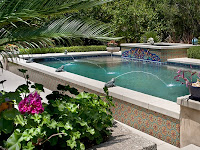Best Swimming Pool Run Time (VS Pump Examples)
No matter how long you run your swimming pool pump, you will not get all the water from the pool through the filter and back out again. So does run time matter? Yes and no. Technically speaking you should try to get at least one cycle of water through the pool, 2-3 cycles all the better as you can see from the study I am referencing below.
You usually need a flow meter attached to your pool equipment to calculate a water cycle. As a rule of thumb, 50 GPM is the average, with a single-speed pump running at 3450 RPM. You can get a ballpark and use this formula if you do not have a flow meter on your equipment.
Pool size/ 50 Gallons Per Minute/ 60 minutes. Here is an example with a 20,000-gallon pool:
20,000 Gal / 50 GPM /60 minutes = 6 hours and 30 minutes
So, a water cycle will go through the pool once every 6.5 hours. But how much pool water will go through the filter and back into the pool? Here is the study abstract for you.
"The primary objective of this study was to conduct a quantitative analysis of the hydraulic efficiency of a 1:25 bench-scale swimming pool and to determine whether the recirculation efficiency could be increased by modifying parameters such as turnover rate, inlet/out configuration, and extent of mixing within the pool. Salt tracer studies were conducted using KCl to determine the residence time distribution and describe the hydraulic characteristics of the pool. The results indicated that removing the tracer always followed an exponential decay curve, i.e., 63, 86, and 95% for the first, second, and third turnover periods, respectively. In most experiments, the exponential decay rate matched the inverse of the system's theoretical hydraulic detention time. The results showed that none of the investigated parameters significantly impacted the tracer removal efficiency. Increasing removal efficiencies of current treatment technologies, such as sand and cartridge filters, from approximately 25–90% would significantly improve the removal rate of Cryptosporidium-sized particles. Improving the treatment efficiency beyond 90% would have little additional impact, but further improvements could be achieved by decreasing the system turnover rate."
Read the complete study here: https://iwaponline.com/jwh/article/16/3/449/39100/A-quantitative-analysis-of-swimming-pool
Does this mean we give up on the one cycle through the filter since it only gets 63% of the water through and will never reach 100% (based on the study, only 95% can be reached)? Certainly not. Since the whole reason for circulation is to prevent bather-to-bather disease, the longer you can run, your pool increases disease prevention. You also prevent algae and poor water quality (cloudy water) by running your pool as much as possible each day during the season.
This study shows that you need to be aware that short run times are ineffective for your pool. The longer run times the better. If you are worried about electricity costs, switching to a Variable Speed (VS) pump would be wise.
Video Outline:
Runtime depends on pool size
Know your pool size
Know your GPM
Having a Clean filter is important
Flow Meter – Flowvis is the best
Intellifo 3 has a flow meter built-in
No flow meter- use 50 gallons per minute as a rule of thumb
VS pumps maximize your energy savings
Single Speed pump is an energy hog 2nd next to AC
One turnover, Two is best during peak season
Pool use is a factor – if in heavy use, 2-3 cycles
Commercial pools 24-hours
You want as much water through the filter as possible so that your sanitizer – usually chlorine- is circulated in the pool effectively.
Getting all the water through – technically never happens
VS Pumps can run as long as 24 hours
Set two speeds: low & Medium
1800 RPM and 2400 RPM
Water clarity & swimmer safety is key
Single Speed Pump: you are setting your run time with an Intermatic timer
Visit my Website: http://www.swimmingpoollearning.com/

Comments
Post a Comment